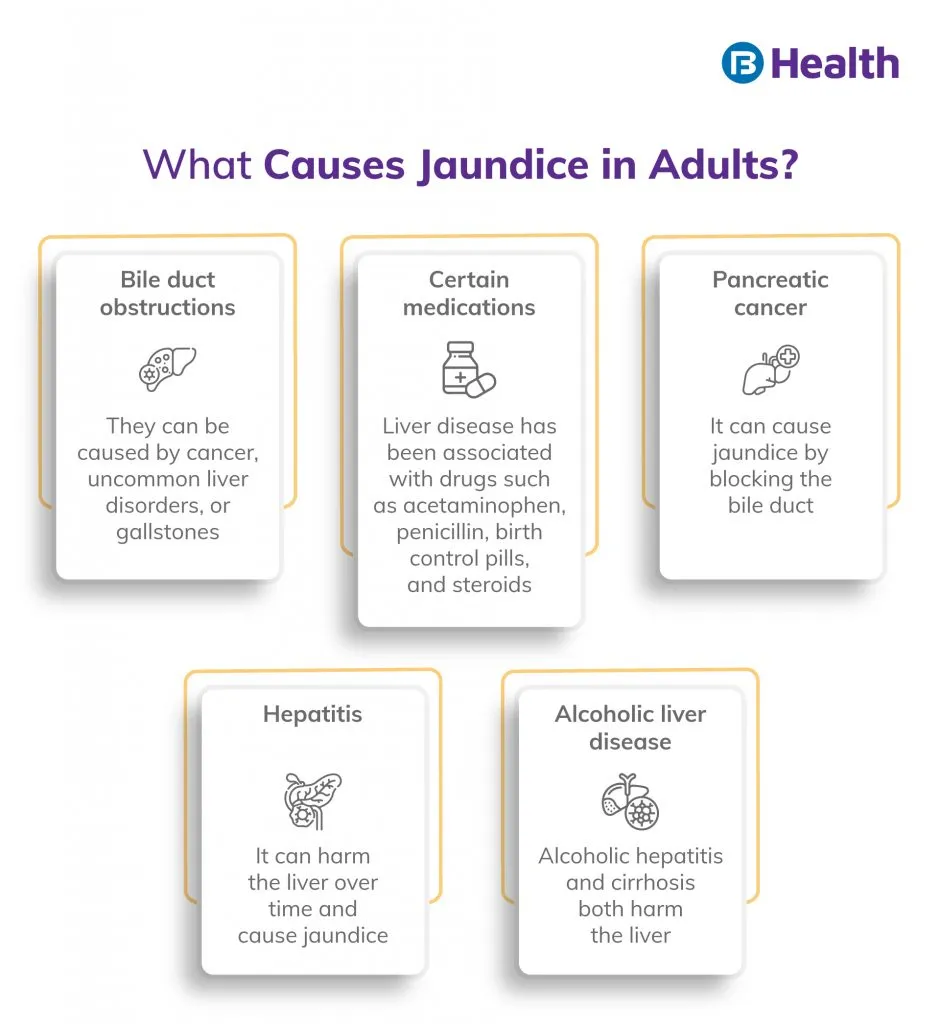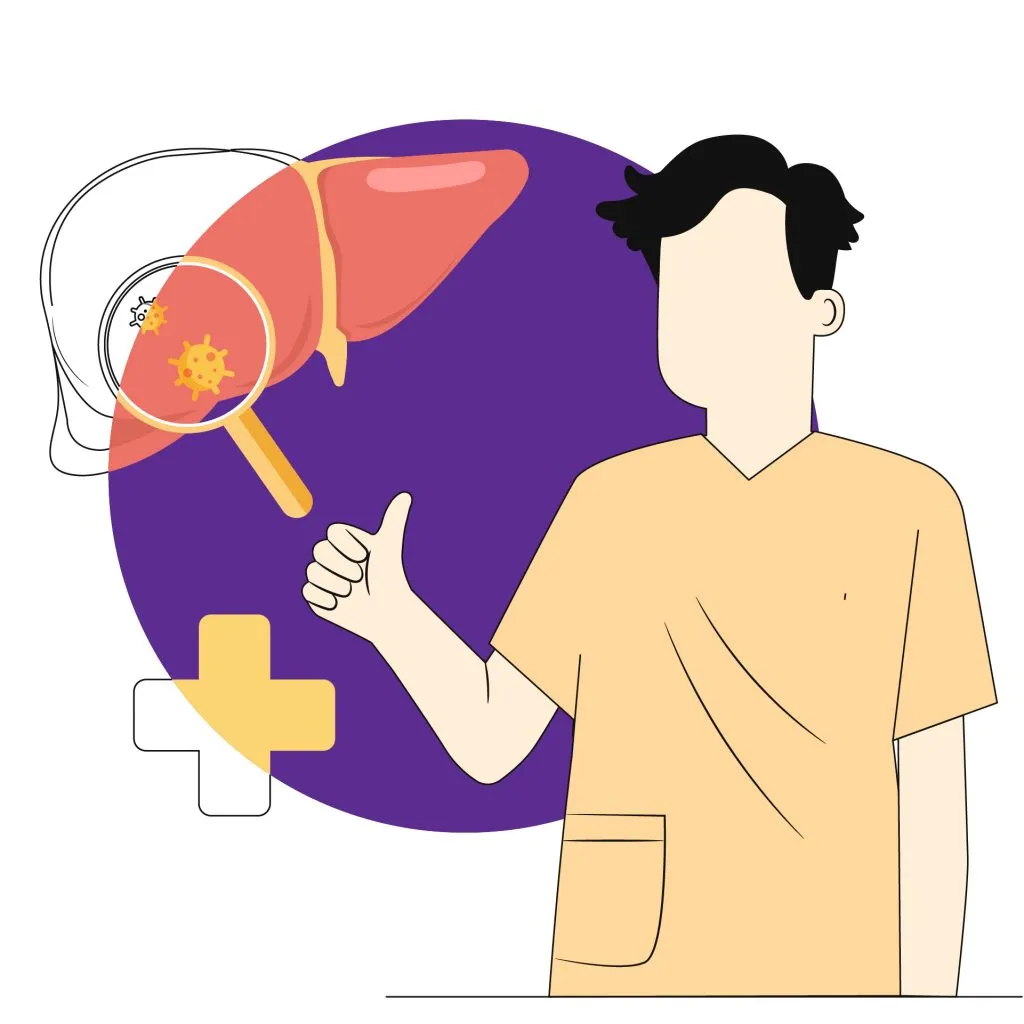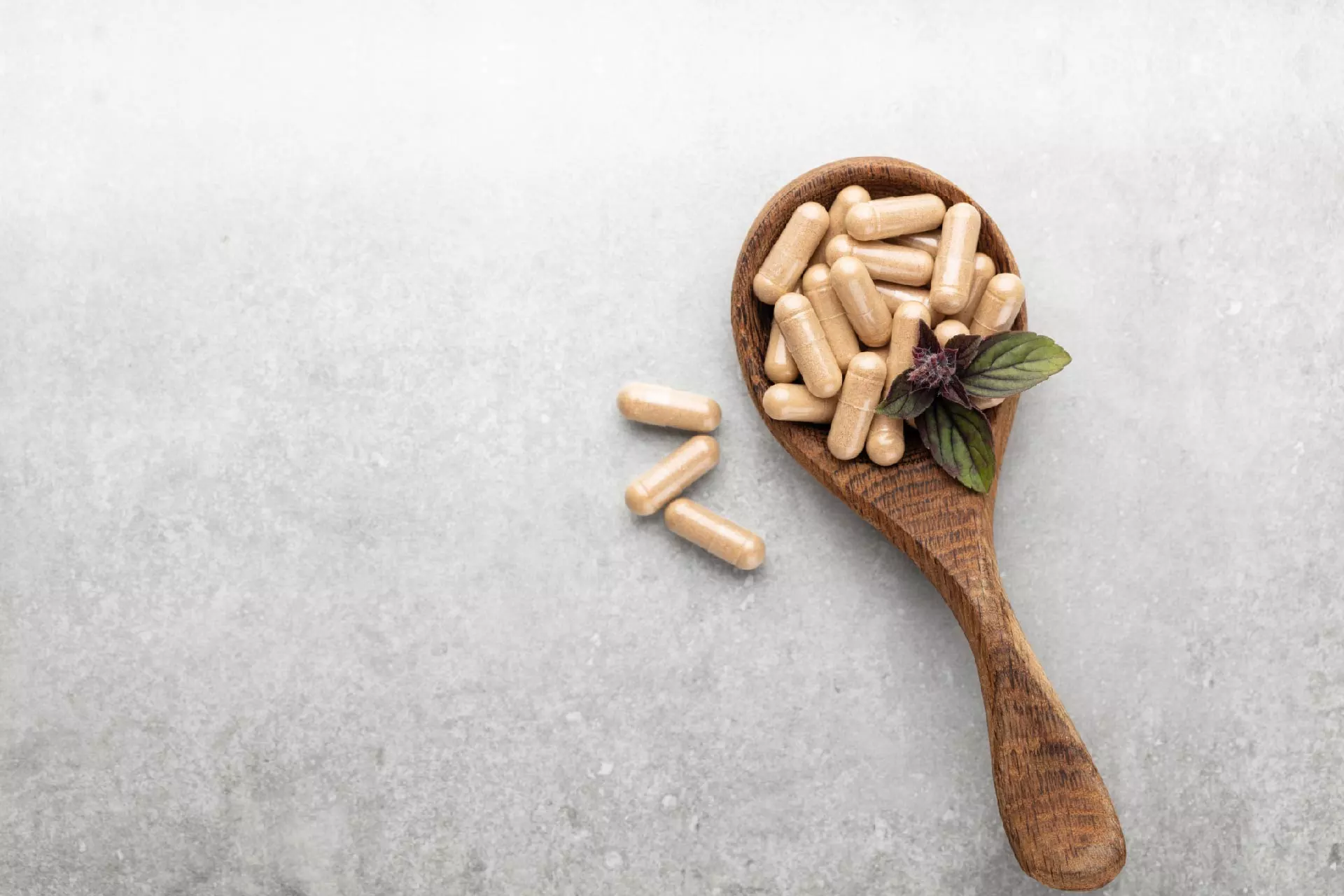General Health | 7 min read
Everything to Know About Jaundice Symptoms, Causes and Treatment
Medically reviewed by
Table of Content
Synopsis
Key Takeaways
- Jaundice is a symptom of an underlying health condition
- Jaundice usually occurs due to liver damage
- Infants can also suffer from jaundice during their first week of life
People often mistakenly define jaundice as a disease. However, jaundice occurs due to the high level of bilirubin in the liver. It is a yellowish pigment formed from the breakdown of red blood cells.
It passes through the liver and, at last, is excreted out of the system. However, when the liver is not working, this waste material builds up in the blood resulting in jaundice disease. Apart from a yellowish tinge, you can also witness other regular symptoms like fever, weakness, and fatigue.
The jaundice symptoms are less common in adults but more in infants. [2] As per records, up to 60% of full-term babies and 80% of premature babies have the risk in their first week. If it remains untreated for a long time, it may become life-threatening and can also lead to brain damage. Hence, it is vital to give attention to developing jaundice symptoms for early diagnosis.
What is Jaundice?
Jaundice is caused by the accumulation of bilirubin in the liver. It is the yellowish pigmentation of tissues, skin, and body fluids. Your skin, eyes, and mucous membrane turn yellow with a moderate bilirubin level. As it increases, the color may transform from yellow to green. [1] As already discussed, bilirubin is formed by the breakdown of red blood cells when the blood passes through the liver and is then excreted. However, when your liver is not functioning, it remains in the body leading to jaundice disease. The jaundice causes also include genetic syndrome, infections, medicines, and liver diseases like hepatitis and cirrhosis.
Additional Read: Newborn Jaundice
What are the Different Types of Jaundice?
Jaundice is classified mainly into three types. Find the types of jaundice below.
- Prehepatic jaundice: It occurs when the RBC exceeds the liver's ability to conjugate bilirubin. As a result, a large number of bilirubin deposits in the blood
- Hepatic jaundice: It occurs due to hepatocyte dysfunction that restricts the uptake and conjugation of bilirubin. There is a hike in the levels of both conjugated and unconjugated bilirubin
- Posthepatic: It occurs after the liver has processed the bilirubin. Although the inflammation, gallstones, and tumours block the path of the bile duct into the intestine
How is Jaundice Caused?
Jaundice is caused by disorders that lead to increased production of bilirubin or restrict the liver from eliminating it. The causes are categorized according to the three phases of bilirubin production.
You may have unconjugated jaundice before the production of bilirubin caused by:
- Hemolytic Anemia: The condition when the red blood cells are destroyed faster than they are made. In this process, the by-product bilirubin is not excreted, leading to a high level of bilirubin.
At the time of bilirubin production, the disorder which leads to jaundice are:
- Hepatitis: It is the inflammatory condition of the liver caused due to autoimmune disease, infection, drugs, blood loss, and alcohol. In this condition, you can witness skin and eyes turning yellow, vomiting, nausea, itching, vomiting, and fatigue. Classified into A, B, and C
- Hepatitis A: This type of inflammation occurs due to hepatitis A infection. It is contagious and spreads through food and water. You can notice pale stool, dark urine, itching, and yellow skin and eyes within a week after the virus attack
- Hepatitis B: The inflammation of the liver occurs due to hepatitis B virus infection. The symptoms include dark urine, pain in joints, and various other jaundice symptoms
- Hepatitis C: Liver disease can be caused due to hepatitis C virus infection. You can notice severe symptoms of fever, loss of appetite, and jaundice
- Alcohol: The overconsumption of alcohol may result in an inflammatory liver condition. The symptoms of alcoholic liver disease include jaundice, bleeding, vomiting, swelling, and pain in the abdomen. It is one of the main causes of jaundice in adults
Symptoms like nausea, loss of appetite, abdominal pain, and change in stool colour are also visible when Jaundice causes the blockage of bile ducts after the production of bilirubin.
The disorder that leads to the condition includes:
- Gallstones: This condition occurs due to the high concentration of bile and bilirubin in the fluid inside the gallbladder. The symptoms are not visible until bile ducts are blocked. You can notice vomiting, dark urine, indigestion, and abdominal pain as symptoms.
- Pancreatic tumour: It is cancer that develops in the lower part of the stomach. In this condition, the tumour blocks the bile duct leading to an increased bilirubin level. Dark urine, itchy skin and light-colour stool are common symptoms.
- Gallbladder cancer: It is cancer that develops in the liver. It disrupts the bilirubin excretion, which elevates the bilirubin in the body. The body tries to eliminate excess bilirubin by depositing it in the skin resulting in jaundice disease.
These are a few conditions which can cause jaundice. If you notice any of the symptoms discussed above, meet the doctor as soon as possible.
Additional Read: Bilirubin Test Normal Range
What are the Early Signs of Jaundice?
Here are a few signs of short-term jaundice disease:- Abdominal pain
- Weakness
- Fever and chills
- Yellowish skin, eye
- Dark urine
- Itchy skin
- Weigh loss
The severity of these signs depends on how quickly the condition develops.
What are the Symptoms of Jaundice?
In some individuals, the jaundice symptoms may not be visible depending upon the seriousness of the condition. Here are a few symptoms seen in adults:
- Fever and chills
- Flu-like symptoms
- Weight loss
- Black stool or vomit
- Severe abdominal pain
- Change in eye and skin colour
- Memory issue
- Bleeding or bruising and rashes, reddish spots
Jaundice symptoms in infants:
- Colour change in skin
- Not sleeping properly
- Trouble waking up
- Change in eye movements
- Lack of interest in feeding
- Abnormal crying
How is the Treatment for Jaundice Administered?
The jaundice treatment in adults depends on the causes of jaundice in adults. In adults, the underlying health condition is treated to cure jaundice. The jaundice treatment for adults and infants differs.Medication: The doctor may prescribe medication to treat the cause. For example, cholestyramine may help to get relief from jaundice symptoms like itchy skin. If the liver damage is serious doctor may suggest a liver transplant depending upon the damage.The doctor usually suggests the following jaundice treatment for infants:
- Phototherapy: The infants are undressed down to diapers and kept under blue-green lights that help to break down the accumulated bilirubin in the skin so that it can be easily excreted from the body
- Excessive Feeding: The doctor may suggest supplementation or frequent feedings
- Blood Protein Transfusion: IV transfusion of immunoglobulin is required if the jaundice is related to the blood type
- Exchange transfusion: This treatment is suggested if jaundice doesn't respond to earlier treatment. In this procedure, the blood is removed slowly and exchanged with the donor's blood
How is it Diagnosed?
The doctor may ask you about your medical history and conduct a physical examination to inspect jaundice symptoms. The liver, skin and abdomen are the main areas of concentration.
Further, they may order the following jaundice test:- Urine testing: The urine analysis to find traces of bilirubin. The positive test result indicates the patient has conjugated jaundice. Further, the finding is verified by serum testing
- Complete blood count (CBC): It measures the levels of white blood cells, red blood cells and platelets
- Hepatitis test: It helps to understand the liver infection range
- Ultrasound scan: Helps to analyze the structure of the liver
The health care providers may also suggest a liver biopsy to check for inflammation, cancer, and cirrhosis.
Additional Read: Prevention of JaundiceWhat are the Complications of Jaundice?
You can expect the following complications associated with jaundice disease. It also depends on the patient's medical condition and types of jaundice.- Severe stomach pain
- Stomach upset
- Constipation
- Bleeding
- Liver failure
- Vomiting and diarrhoea
- Abdominal bloating
Severe cases of jaundice may also lead to brain damage called kernicterus, especially in infants.
Many people get panicked seeing jaundice symptoms. Although the good news is it is treatable. With the medication and treatment, you can easily recover from jaundice. The recovery time may differ depending on the patient's health condition. Try not to miss routine check-ups and follow the medication as the doctor prescribed for early recovery.
If you are looking for guidance from experts, sign in to Bajaj Finserv Health. Here you can seek professional's advice at your comfort through online doctor consultation. To book a general physician's consultation, you have to register your details and book the slot. One step of care can prevent any disease!
References
- https://www.ncbi.nlm.nih.gov/books/NBK544252/
- https://www.ncbi.nlm.nih.gov/pmc/articles/PMC5913776/
Disclaimer
Please note that this article is solely meant for informational purposes and Bajaj Finserv Health Limited (“BFHL”) does not shoulder any responsibility of the views/advice/information expressed/given by the writer/reviewer/originator. This article should not be considered as a substitute for any medical advice, diagnosis or treatment. Always consult with your trusted physician/qualified healthcare professional to evaluate your medical condition. The above article has been reviewed by a qualified doctor and BFHL is not responsible for any damages for any information or services provided by any third party.





